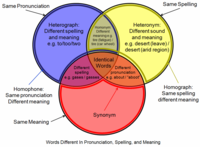
Photo from wikipedia
This study examined how the relatively high degree of tonal homophony in spoken Mandarin affects learners’ perception and production of new syllable-tone words. Seventeen English-speaking-learners of L2 Chinese participated in… Click to show full abstract
This study examined how the relatively high degree of tonal homophony in spoken Mandarin affects learners’ perception and production of new syllable-tone words. Seventeen English-speaking-learners of L2 Chinese participated in a 3-day word-learning task in which pictures were paired with spoken syllable-tone words. Stimuli included 32 monosyllabic Chinese words (e.g., yu3 “feather”). 16 words corresponded to previously learned syllable-tone homophones (e.g., yu3 “language”); 16 words were previously unlearned combinations (e.g., yu4 “jade”). Learning was assessed on day 3 using a 4-alternative-forced-choice identification task and a picture-naming task. Twelve Chinese-L1 speakers identified the learners’ productions. Learners were overall more accurate at identifying words that had no previously learned homophone (94%) than words that lacked homophones (90%). The opposite trend was observed in production: learners were overall more accurate at producing words that corresponded to previously learned homophones (77%) than words that lacked homophones (72%). Mixed-effects logistic regression models revealed no statistical difference of the log odds of correct identification or production. These results indicate that despite encountering considerable tonal homophony in speech, learners did not gain advantage in perceiving or producing new words with homophones. The phonologically marked T2-T3 contrast was produced with the lowest accuracy relative to other tonal contrasts.This study examined how the relatively high degree of tonal homophony in spoken Mandarin affects learners’ perception and production of new syllable-tone words. Seventeen English-speaking-learners of L2 Chinese participated in a 3-day word-learning task in which pictures were paired with spoken syllable-tone words. Stimuli included 32 monosyllabic Chinese words (e.g., yu3 “feather”). 16 words corresponded to previously learned syllable-tone homophones (e.g., yu3 “language”); 16 words were previously unlearned combinations (e.g., yu4 “jade”). Learning was assessed on day 3 using a 4-alternative-forced-choice identification task and a picture-naming task. Twelve Chinese-L1 speakers identified the learners’ productions. Learners were overall more accurate at identifying words that had no previously learned homophone (94%) than words that lacked homophones (90%). The opposite trend was observed in production: learners were overall more accurate at producing words that corresponded to previously learned homoph...
Journal Title: Journal of the Acoustical Society of America
Year Published: 2018
Link to full text (if available)
Share on Social Media: Sign Up to like & get
recommendations!